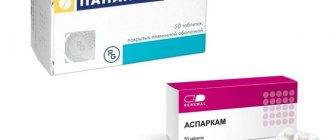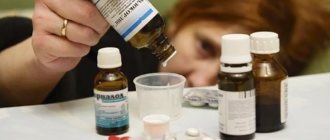Home>Articles> How dangerous is it to take Corvalol and Valocordin with alcohol?
quick menu (hide)
- Compatibility of Valocordin and alcohol
- In what cases can you combine drugs with alcohol?
- What can you buy at the pharmacy for a hangover?
- Traditional medicine for hangovers
Preparations containing phenobarbital are incompatible with alcohol. This rule applies to Corvalol, Valocordin, Valoserdin. You can drink such heart remedies some time before drinking alcohol, or after drinking libations, having agreed upon this possibility with your doctor.
What is the difference between them?
Valocordin and Corvalol belong to the group of drugs that have antispasmodic and sedative effects, which is due to the phenobarbital they contain.
Corvalol is close in composition to Valocordin; these drugs have the same components, however, they differ in their mechanism of action.
Compound
Corvalol and Valocordin contain common components such as:
- Phenobarbital is a substance included in the group of barbiturates, which explains its sedative effect on the nervous system. When taken over a long period of time, barbiturates can be addictive.
- Alpha-bromoisovaleric acid - has a sedative, analgesic and mild hypnotic effect, which is due to the combination of isovaleric acid and bromine on the central nervous system.
- Peppermint oil is also used as a mild sedative that reduces stress on the central nervous system. The presence of mint oil in Valocordin and Corvalol helps relieve anxiety, irritability, and overexcitement.
- Ethyl alcohol acts as a solvent for all components of the drug and has a depressant effect on the central nervous system.
The difference in the compositions of these drugs is that in Corvalol, in addition to the listed components, there is caustic soda, which converts phenobarbital into a soluble form (phenobarbital sodium), and Valocordin, in addition to mint, contains hop oil, which has a strong sedative effect.
Price and manufacturers
In addition to the composition, Valocordin and Corvalol differ in price, since they have different manufacturers.
Valocordin is produced by a German company (Krewel Meuselbach GmbH), so it costs much more. Its cost ranges from 130 to 150 rubles. for 20 ml.
The producers of Corvalol are Russian companies (Marbiopharm, Samaramedprom, Permpharmacia, Dalkhimfarm, etc.). The cost of the drug is on average 15 - 20 rubles. for 25 ml. In addition, Corvalol is also available in tablets (about 120 rubles per pack).
Corvalol and alcohol - compatibility
Corvalol is created on the basis of phenobarbital. This substance belongs to the group of psychotropics, which requires extremely careful use of the drug.
Combining Corvalol and alcohol can provoke:
- Severe delirium (mental disorder).
- Impaired brain function.
- Pain in various parts of the body.
- Withdrawal syndrome, reminiscent of withdrawal in drug addicts.
- Comatose states.
The instructions included with Corvalol contain information regarding its incompatibility with alcoholic beverages . Ethanol can greatly enhance the toxic properties of this drug, as well as unwanted side effects. If shortly before or after taking Corvalol a person drinks even a small amount of alcohol, this can cause the development of negative consequences (pronounced “inhibition” and others).
Which is better and in what case?
Corvalol and Valocordin are widely used in the treatment of nervous and cardiovascular diseases, but each is more effective in certain cases.
Valocordin
This drug is recommended for use for sinus tachycardia and cardialgia. With its help, the patient can get rid of insomnia, anxiety, neuroses and feelings of fear.
Valocordin relieves agitation well; in addition, it is recommended to take it for high blood pressure. Phenobarbital, which is part of the drug, has a sedative and hypnotic effect, and ethyl esters and essential oils enhance its effectiveness, relieving vasospasm.
Corvalol
This medicine is essentially an analogue of Valocordin, and in most cases is prescribed for neuroses and stress, which are accompanied by increased excitability and irritability. It normalizes sleep and is actively used for cardiovascular symptoms and hypertension, as Corvalol gently reduces blood pressure.
Despite the fact that this drug is widely used as a sedative and hypnotic, it should be borne in mind that its long-term excessive use leads to addiction, decreased effectiveness and oversaturation of the body with bromine.
What is the difference between Validol and Valocordin?
The history of Valocordin begins in the middle of the twentieth century, when the German drug Corvalol appeared, the chemical composition of which was adapted for production in the USSR.
This is probably the main difference between Corvalol and Valocordin. By the way, it is no longer prescribed in Europe, and it is produced “exclusively” for the countries of the post-Soviet space. The action of Corvalol has something in common with the action of some components of Valocordin, but Valocordin is a complex medicine, and Corvalol is a single drug (with one active ingredient).
Contraindications and complications in case of overdose
It is necessary to take into account the possible harm of drugs when taken uncontrolled. There is a danger of overdose, accompanied by a sharp drop in blood pressure and collapse, disruption of the central nervous system due to the action of cardiac drugs. In addition, many patients may experience severe depression, weakness, and lack of coordination.
Contraindications to taking these drugs are pregnancy, hypersensitivity to the components that make up them, impaired kidney and liver function, as well as injuries and diseases of the central nervous system. In addition, Corvalol and Valocordin are not recommended for use in cases of pronounced hypotension and in patients under 18 years of age.
And also Valocordin and Corvalol should not be taken by patients who, due to their activities, must be attentive, for example, drivers. This is caused by the presence of alcohol and phenobarbital in the drugs, which have a depressing effect on the central nervous system.
Give me medicine for arrhythmia!
The concept of “arivitamin for the heart.” This is complete nonsense; such “vitamins” do not exist in nature. The heart is not a strawberry patch, and medicine is not manure. So in most cases it is a waste of money.
Beta blockers (anaprilin, obzidan, atenolol, concor). These drugs slow down the pulse and can actually be effective for certain types of arrhythmia (tachycardia, extrasystole). But they can also be ineffective, and they can also be harmful.
In order for a doctor to prescribe such drugs, he needs to carefully analyze at least a cardiogram. Blindly, without monitoring the heart rate, without knowing the mechanism of arrhythmia, these drugs can be dangerous, especially in older people.
What can replace them?
Valocordin and Corvalol are popular exclusively in the post-Soviet space.
Many countries around the world have abandoned their use, citing the lack of a proven effect and the harmfulness of phenobarbital to the body, but a more likely reason is the struggle of pharmaceutical companies for a market niche in the field of sedatives.
Currently, there are many drugs that have a similar effect.
The most commonly used:
| № | Name of the drug | Release form | Price |
| 1 | Adonis-bromine | Tab. (pack of 20 pcs.) | From 50 rub. |
| 2 | Arboval | Cap. (25 ml.) | From 75 rub. |
| 3 | Corvaldin | Cap. (25 ml.) | From 60 rub. |
| 4 | Valeriana Forte | Tab. 0.04 No. 50 | From 140 rub. |
| 5 | Carniland | Cap. (25 ml.) | From 100 rub. |
| 6 | Valoserdin | Cap. (50 ml.) | From 105 rub. |
| 7 | Valeodicramen | Cap. (25 ml.) | From 115 rub. |
| 8 | Bellataminal | Tab. (pack of 30 pcs.) | From 160 rub. |
| 9 | Cliophyte | Elixir (250 ml.) | From 180 rub. |
| 10 | Valemidin | Cap. (50 ml.) | From 195 rub. |
| 11 | Persen | Tab. (20 pcs.) | From 180 rub. |
Sometimes Valocordin and Corvalol are replaced with Validol tablets or drops. This drug relieves an alarming symptom and normalizes the pulse during arrhythmia.
Along with these drugs, Corvalol can be replaced with medicinal preparations (Sedative No. 1, 2, 3, 4 and 5) and other natural-based products containing motherwort, lemon balm, mint, etc. This group includes Novo-Passit, liquid hop extract, Fito Novo-Sed, Fitorelax, Soothing, etc.
It should be borne in mind that all of the listed products have different compositions, but have properties similar to Valocordin and Corvalol. With complex therapy, they improve the patient’s general condition, but each of them has contraindications, so before using them you need to consult a doctor.
How to reduce blood pressure?
This is another painfully popular question for pharmacy workers. I’ll say right away that there is no answer to this and there cannot be one.
In order to select your initial treatment for hypertension, I need at least 15–20 minutes of time and knowledge of about 20 indicators (heredity, concomitant diseases, examination data, tests, etc.). Even so, there is a certain chance that the treatment will have to be adjusted, perhaps more than once.
And we want a panacea from the pharmacist in 30 seconds. The most that an exhausted pharmacist will give you under threat of a complaint is either a short-acting drug or a dummy.
Dibazole, papazole. A relic from the last century, when hypertension was considered the result of vasospasm and was treated accordingly with antispasmodics. In fact, the effect of these drugs is zero, it’s just that in some people the pressure drops on its own while they think that the drug is working. Decent people do not use these “medicines” either in tablets or in injections.
Andipal. The same antispasmodics in combination with analgin and the already familiar phenobarbital. It has nothing to do with hypertension. Another disgrace of the Russian pharmacopoeia.
Nifedipine (Corinfar). A favorite remedy for all Russian hypertensive patients to quickly lower blood pressure. I have already explained in detail why you should not use Corinfar, that the harm from a quick “collapse” of pressure outweighs the benefit, that Corinfar increases, and does not at all reduce, the risk of stroke, that it is much better to reduce the pressure smoothly and gradually, and not with a dashing cavalry charge... Vessels are bad withstand sudden pressure surges, for a rapid drop from 220 to 140 mm Hg. Art. they won't say thank you.
Captopril (capoten). This is a lesser evil in terms of treating a hypertensive crisis than Corinfar; it is even included in international recommendations as an “ambulance” drug, but there is an important nuance here. Hypertensive patients often confuse a hypertensive crisis with simply high blood pressure in an untreated person.
A hypertensive crisis is a situation when a patient receiving good, regular, obviously effective therapy suddenly experiences a sharp one-time rise in blood pressure (for example, against the background of severe stress). In this case, captopril is suitable.
But if we are talking about a person who is constantly not treated, but simply “knocks down” randomly measured high values of high blood pressure, then this is no longer the path FROM a stroke, but TO a stroke . Hypertension requires constant, daily, usually lifelong treatment.
Aspirin for blood thinning
The idea of taking aspirin just like that, for prevention, “to thin the blood,” because “all friends over 45 already take it,” was very popular just recently. It was believed that aspirin's ability to prevent platelet aggregation could significantly reduce the risk of myocardial infarction and other vascular accidents.
However, it turned out that if a healthy or almost healthy person takes aspirin, the number of heart attacks prevented is very small, but the risk of bleeding increases. Therefore, cardiologists around the world are gradually reconsidering the idea of the preventive role of aspirin in healthy people, prescribing it only to patients with coronary heart disease (including after myocardial infarction and bypass surgery/stenting), patients after a stroke, as well as with severe atherosclerosis of the blood vessels of the legs.
In other words, you should not take aspirin on your own, without a doctor’s recommendation.
It is bad when the patient does not have one attending physician who would completely control the therapy. In this case, the patient independently goes from doctor to doctor, collecting prescriptions for the treatment of various diseases. For some reason, every doctor considers it his duty to prescribe at least four or five drugs, which seems to be frivolous otherwise. If the patient decides to take all of this, 15–20 items will appear in his medicine cabinet at the same time. Sometimes patients come to me with a specific task: “Doctor, the clinic prescribed me a total of 20 medications. Help me reduce their number..."
Advertising
Medications to take regularly for panic attacks
Constant use of pharmacotherapy allows you to stabilize the biochemical and physiological processes in the nervous system that are responsible for the development of panic attacks.
Basically, such drugs act on specific receptors in the brain and restore the normal activity of neurotransmitters: dopamine, serotonin, norepinephrine, adrenaline, acetylcholine and others.
Antidepressants
Mainly affects serotonin receptors of the nervous system. They are used in courses of several months (from three to more than a year). The most “popular” and common antidepressants for preventing panic attacks:
- Escitalopram (cipralex, elicea);
- Paroxetine (Paxil);
- Amitriptyline;
- Sertraline (Zoloft);
- Fluvoxamine (fevarin).
Neuroleptics
They act predominantly on dopamine receptors in the brain. Prescribed in cases where panic attacks are a manifestation of an endogenous disease. Like antidepressants, they are taken for a long time from several months to several years.
Contrary to popular belief among people with anxiety disorders, they do not cause addiction. The most commonly used antipsychotics for long-term treatment of panic attacks are:
- Thioridazine (Sonapax);
- Sulpiride (eglonil);
- Quetiapine (Seroquel);
- Risperidone (rispolept);
- Flupenthixol (fluanxol).
Normotimic drugs
Their mechanism of action is the normalization of the ratio of excitation and inhibition processes in the brain. Most effective for panic attacks due to encephalopathy, consequences of traumatic brain injuries, strokes, and hypoxia.
The most common representatives of normotimics:
- valproic acid (Depakine Chrono),
- lamotrigine (Lamictal),
- carbamazepine (finlepsin).
To summarize, it can be noted that among the above-listed medications there are several drugs with a universal effect: they are suitable both for a single dose to quickly relieve a panic attack, and for long-term use. These are the antidepressant amitriptyline and the antipsychotics quetiapine, thioridazine and sulpiride.
This material is for informational purposes only. Under no circumstances should you use the medications described above for panic attacks on your own. Any use of the drug should only be as prescribed by a doctor! Don't self-medicate!
Which drug is better
The drugs Valocordin and Valoserdin are interchangeable analogues. The difference is in cost. The domestic drug Valoserdin is cheaper. Another difference is the active ingredient. The composition is identical except for one substance. Valocordin contains hop extract, Valoserdin contains oregano.
Both drugs are popular due to their low cost and effectiveness. However, self-medication is not recommended. You should consult a specialist to select an effective remedy.










